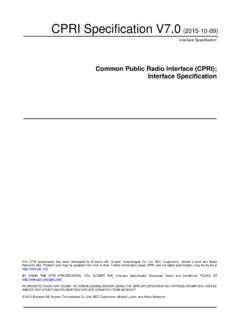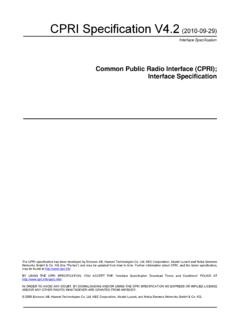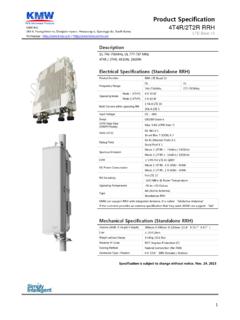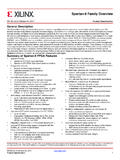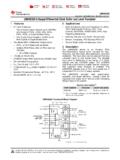Transcription of CPRI Specification V1 - Common Public Radio Interface
1 CPRI Specification (2006-03-31) Interface Specification Common Public Radio Interface (CPRI); Interface Specification The CPRI Specification has been developed by Ericsson AB, Huawei Technologies Co. Ltd, NEC Corporation, Nortel Networks SA and Siemens AG (the Parties ) and may be updated from time to time. Further information about CPRI, and the latest Specification , may be found at BY USING THE CPRI Specification , YOU ACCEPT THE Interface Specification Download Terms and Conditions FOUND AT IN ORDER TO AVOID ANY DOUBT, BY DOWNLOADING AND/OR USING THE CPRI Specification NO EXPRESS OR IMPLIED LICENSE AND/OR ANY OTHER RIGHTS WHATSOEVER ARE GRANTED FROM ANYBODY. 2004 Ericsson AB, Huawei Technologies Co. Ltd, NEC Corporation, Nortel Networks SA and Siemens AG.. CPRI CPRI Specification (2006-03-31)2 Table of Contents 1. Introduction.
2 4 2. System Description .. 5 5 System Architecture .. 6 Reference Configurations .. 7 Functional Description .. 8 3. Interface 9 Supported Radio 9 Operating Range .. 9 Topology/Switching/Multiplexing .. 9 Bandwidth/Capacity/Scalability .. 10 Capacity in terms of 10 Required U-plane IQ Sample 10 Required C&M-plane Bit Rate .. 11 Synchronization/Timing .. 11 Frequency Synchronization .. 11 Frame Timing Information .. 12 Absolute Timing Accuracy .. 12 Round Trip Delay 12 Delay 13 Link 13 Quality of 14 Maximum Delay .. 14 Bit Error Ratio U-plane .. 14 Bit Error Ratio C&M-plane .. 14 Start-up Requirement .. 15 Clock Start-up Time Requirement .. 15 Plug and Play 15 4. Interface Specification .. 16 Protocol Overview .. 16 Physical Layer (Layer 1) Specification .. 17 Line Bit Rate .. 17 Physical Layer Modes .. 17 Electrical 18 Optical Interface .
3 18 Line Coding .. 18 Bit Error 19 Frame Structure .. 19 Synchronisation and Timing .. 32 Delay 32 Link Maintenance of Physical Layer .. 33 Data Link Layer (Layer 2) Specification for Slow C&M 36 Layer 2 Framing .. 36 Media Access Control/Data Mapping .. 37 Flow Control .. 37 Control Data Protection/ Retransmission 37 Data Link Layer (Layer 2) Specification for Fast C&M 37 Layer 2 Framing .. 37 Media Access Control/Data Mapping .. 38 Flow Control .. 41 Control Data Protection/ Retransmission 41 Start-up Sequence .. 41 CPRI CPRI Specification (2006-03-31)3 General .. 41 Layer 1 Start-up Timer .. 41 State 42 Transition 47 5. 50 Forward and Backward Compatibility .. 50 Fixing Minimum Control Information Position in CPRI Frame Structure .. 50 Reserved Bandwidth within 50 Version Number .. 50 Specification Release Version mapping into CPRI Frame.
4 50 Compliance .. 51 6. Annex .. 52 Delay Calibration Example (Informative).. 52 Electrical Physical Layer Specification (Informative).. 53 Overlapping Rate and Technologies .. 53 Signal Definition .. 53 Eye Diagram and 54 Reference Test 54 Cable and Connector .. 55 Impedance .. 55 AC Coupling .. 55 TX Performances .. 56 Receiver 58 Measurement Procedure .. 60 7. List of Abbreviations .. 61 8. References .. 63 9. 64 CPRI CPRI Specification (2006-03-31)4 1. Introduction The Common Public Radio Interface (CPRI) is an industry cooperation aimed at defining a publicly available Specification for the key internal Interface of Radio base stations between the Radio Equipment Control (REC) and the Radio Equipment (RE). The parties cooperating to define the Specification are Ericsson AB, Huawei Technologies Co. Ltd, NEC Corporation, Nortel Networks SA and Siemens AG.
5 Motivation for CPRI: The CPRI Specification enables flexible and efficient product differentiation for Radio base stations and independent technology evolution for Radio Equipment (RE) and Radio Equipment Control (REC). Scope of Specification : The necessary items for transport, connectivity and control are included in the Specification . This includes User Plane data, Control and Management Plane transport mechanisms, and means for synchronization. A focus has been put on hardware dependent layers (layer 1 and layer 2). This ensures independent technology evolution (on both sides of the Interface ), with a limited need for hardware adaptation. In addition, product differentiation in terms of functionality, management, and characteristics is not limited. The Specification will have the following scope: 1. A digitized and serial internal Radio base station Interface between Radio Equipment Control (REC) and Radio Equipment (RE) will be specified.
6 2. Three different information flows (User Plane data, Control and Management Plane data, Synchronization Plane data) will be multiplexed over the Interface . 3. The Specification will cover Layers 1 and 2. 3a. The physical layer (layer 1) will support both an electrical Interface ( , what is used in traditional Radio base stations), and an optical Interface ( for Radio base stations with remote Radio equipment). 3b. Layer 2 will support flexibility and scalability. The Specification shall comply with 3 GPP UTRA FDD release 6. Radio Equipment (RE) Radio Equipment Control (REC)Layer 1 Layer 2 Control & Radio Base StationInternal Interface xpecificationLayer 1 Layer 2 Control & Figure 1: System and Interface Definition CPRI CPRI Specification (2006-03-31)5 2. System Description This chapter describes the CPRI related parts of the basic Radio base station system architecture and defines the mapping of the functions onto the different subsystems.
7 Furthermore, the reference configurations and the basic nomenclature used in the following chapters will be defined. The following description will be based on the UMTS (Universal Mobile Telecommunication System) nomenclature, because this is the first mobile Radio standard the Common Public Radio Interface (CPRI) Specification supports. However, the Interface may also be used for other Radio standards. Definitions/Nomenclature This section provides the basic nomenclature that will be used in the following chapters. Subsystems: The Radio equipment control and the Radio equipment are described in the following chapter. Protocol layers: This Specification defines the protocols for the physical layer (layer 1) and the data link layer (layer 2). Layer 1 defines: Electrical characteristics Optical characteristics Time division multiplexing of the different data flows Low level signalling Layer 2 defines: Media access control Flow control Data protection of the control and management information flow Protocol data planes: The following data flows can be discerned: Control Plane: Control data flow used for call processing.
8 Management Plane: Management information for the operation, administration and maintenance of the CPRI link and the RE. User Plane: Data that has to be transferred from the Radio base station to the mobile station and vice versa. These data are transferred in the form of IQ data. Synchronization: Data flow which transfers synchronization and timing information between REC and RE. The control and management plane will be mapped to a single information flow over the CPRI link. User plane data: The user plane data are transported in the form of IQ data. Several IQ data flows will be sent via one physical CPRI link. Each IQ data flow reflects the data of one antenna for one carrier, the so-called antenna-carrier (AxC). Antenna-carrier (AxC): One antenna-carrier is the amount of digital baseband (IQ) U-plane data necessary for either reception or transmission of one UTRA-FDD carrier at one independent antenna element.
9 AxC Container: It contains the IQ samples of one AxC for one UMTS chip duration. CPRI CPRI Specification (2006-03-31)6 Service Access Points: For all protocol data planes layer 2 services access points are defined that will be used as reference points for performance measurements. These service access points will be denoted as SAPCM, SAPS and SAPIQ as illustrated in Figure 2 Downlink: Direction from REC to RE. Uplink: Direction from RE to REC. System Architecture Future Radio base stations should provide deployment flexibility for the mobile network operators, , in addition to a concentrated Radio base station, more flexible Radio base station system architectures involving remote Radio equipment shall be supported. This can be achieved by a decomposition of the Radio base station into two basic building blocks, the so-called Radio equipment control (REC) and the Radio equipment (RE) itself.
10 Both parts may be physically separated ( , the RE may be close to the antenna, whereas the REC is located in a conveniently accessible site) or both may be co-located as in a conventional Radio base station design. The Radio equipment control provides access to the Radio Network Controller via the Iub Interface (for the UMTS Radio access network), whereas the Radio equipment serves as the air Interface to the user equipment (in an UMTS network this is called the Uu Interface ). The REC comprises the Radio functions of the digital baseband domain, whereas the RE contains the analogue Radio frequency functions. The functional split between both parts is done in such a way that a generic Interface based on In-Phase and Quadrature (IQ) data can be defined. A more detailed description of the functional split between both parts of an UMTS system is provided in Section In addition to the user plane data (IQ data), control and management as well as synchronization signals have to be exchanged between the REC and the RE.




